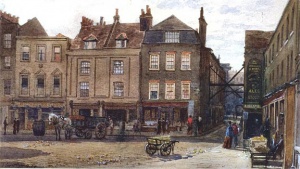St James Place
St James Place was, in 1888, an open square which held a daily market that sold fruits of various kinds. However it was the fruit of the orange tree that was the most predominant and therefore the locals gave this market the name of 'Orange Market'. It was here that Joseph Barnett worked for a period.
In the middle of St James Place stood a manned Fire Station. Made of wood, it was around 1888 that this structure was converted to brick. It had 3 men on duty over the evening period and outside was a cart with ladders. Next to this station was a free standing gas lamp. Another lamp was situated right above the covered entrance of St James passage that led to Mitre Square. Apart from St James Passage, access to the Place could be obtained via Little Duke Street (which crossed the top of Duke Street from Houndsditch to St James Place) in the east, or King Street in the west.
During the night of Catherine Eddowes' murder, St James Place was patrolled by PC Edward Watkins, however he was not the sole watcher of this area. James Blenkinsopp (other reports have his surname spelt 'Blenkingsopp') was the nightwatchman overseeing some street repairs in St James Place. He reported nothing suspicious, though he was questioned by a man at around 1.30am, a quarter of an hour before Catherine Eddowes' body was discovered. Blenkinsopp reports that a well dressed man asked him this question :- "Have you seen a man and a woman go through here?". Blenkinsopp's reply was in the negative and the man departed. This is a curious event because if Blenkinsopp's timing is correct, then this event happened minutes before the Joseph Lawende sighting in Duke Street. If Blenkinsopp was incorrect with the timing, then it is possible that it was one of the Detective Constables (possibly DC Daniel Halse) who was enquiring after the discovery of Eddowes' body. The fact that the questioning does not appear in any of the surviving City Police records throws more conjecture onto this event.
One of the buildings surrounding St James Place was The Jewellery Mart Public House. The house was frequented by the Jews and, at one time, served as a place where the Jewish Jewellers (which, around 1888, dominated the Houndsditch environs) in the area could trade amongst themselves.
St. James' Place was later renamed Creechurch Place.

